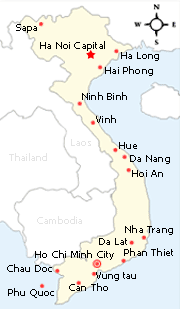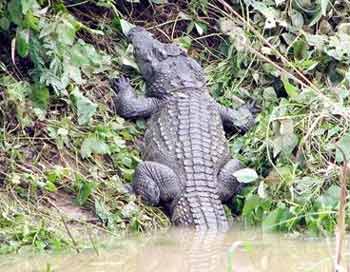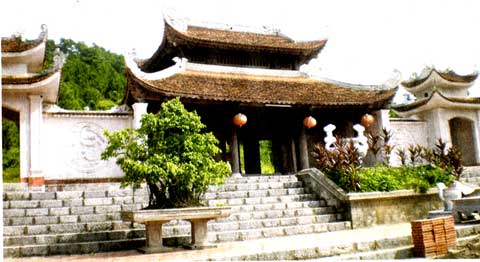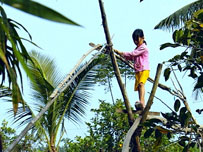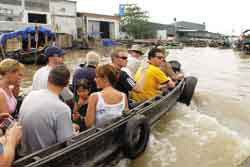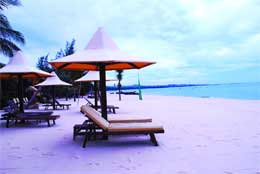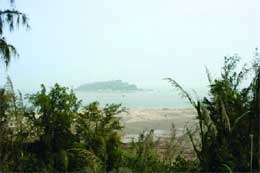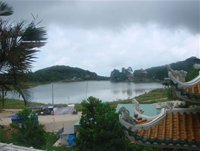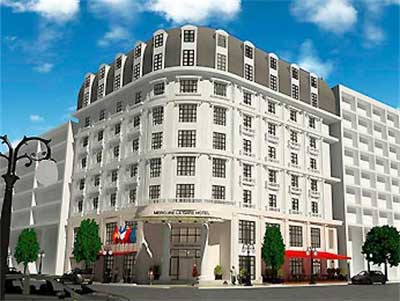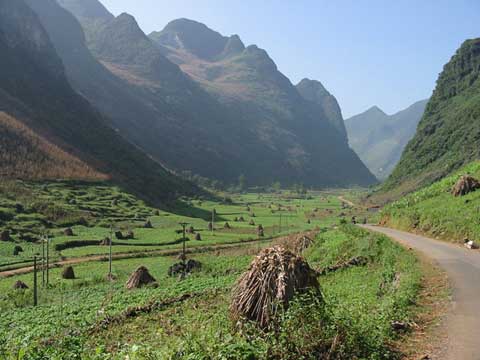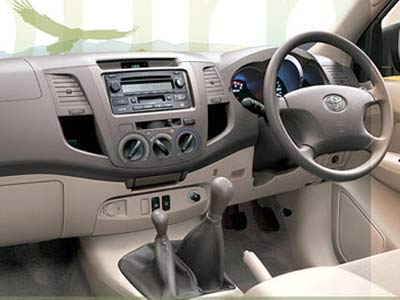Vietnam Open Tour News & EventsMekong Delta: Watch out for crocodiles! Unreliable cages mean that crocodile escape to the rivers and canals during transportation and attack people. More and more such reports from Mekong Delta provinces frighten local residents.
A Kien Giang Provincial Forest Protection Bureau official says that local rangers have killed a crocodile 1.6m long, weighing 20kg, after it escaped from a crocodile farm in Ha Tien Town. Locals complain there is still another loose crocodile in the area.
Mrs. Nguyen Hong Le of Can Tho was attacked by a crocodile when she held her 1-year old baby at a canal bank near her home on March 22nd. Luckily, the crocodile didn’t snap up the woman. She ran and called for help. It took local people half an hour to catch the crocodile, which had escaped from its cage at a neighbor’s home.
In mid-May 2009, Hau Giang province residents discovered a crocodile in Nang Mau canal. The animal has not yet been captured.
Nguyen Thi Bay, a fisherwoman in Can Tho city, says her family caught six baby crocodiles from a nearby canal. She sold all six as pets for 500,000 dong/head. Because regulation enforcement is almost nonexistent, many people build cages in their gardens to breed crocodiles as pets.
On July 20th, a crocodile escaped to a river in Bac Lieu province while being transported. Several days ago, the local people caught another crocodile in the same river, which had also escaped during transport.
“Kids often have bath in the river, so we are very worried about crocodiles on the loose,” explains Nguyen Thi Nguyen in Bac Lieu province.
Who is responsible for escaped crocodiles?
Breeding crocodiles in the Mekong Delta is nearly out of control. Phan Thi Hong from Can Tho city, is breeding 180 crocodiles. Hong said four years ago, when she began raising the animals, she registered with the local Department of Agriculture and Rural Development. Since then, the department has inspected her crocodile farm only once.
In Bac Lieu province, most crocodile breeders have several to several dozen crocodiles. They rear them as part of hunger eradication and poverty reduction projects. Phuoc Long district alone has several thousand families breeding around 56,000 crocodiles. Most don’t register with local authorities and they have to transport their crocodiles to other provinces for sale. Some crocodiles have escaped on the way, but no one admits responsibility for them.
Nguyen Quoc Hung, Vice Chief of the Department of Agriculture and Rural Development of Phuoc Long district, acknowledges: “Crocodile farmers have to seek the market for crocodiles by themselves. The local agricultural department doesn’t have any effective measure to control crocodile breeding, transporting and trading activities”.
Nguyen Vinh Phuc, chief of the Forest Protection Department of Hau Giang province, reports that there are only 15 families registered to rear crocodiles in Hau Giang, but the real number of breeders is many times higher.
“We plan to arrange for the Forest Protection Bureau to control crocodile farms,” notes an official from the Can Tho Department of Agriculture and Rural Development.
VietNamNet/Dat Viet
A glimpse of Kinh Chu and An Phu Not as popular as Con Son Tourist Site or Kiep Bac Temple, Kinh Chu Grotto and An Phu Tourist Site in the northern province of Hai Duong are luring more and more tourists with their charm and historical significance.
Nestled Imposingly at the top of An Phu Mountain at a height of 246 meters, the temple, surrounded by picturesque landscapes, is built, in elegant ancient architecture. Halfway down the mountain are Tuong Van Pagoda and Thanh Mau Temple. The green of the moss on the seasoned trees makes the sanctuary more peaceful and secretive. Some of green trees have lived for centuries. Like the motifs of other ancient pagodas, the front of Tuong Van Pagoda is a well with clear and clean water year round. From the top of An Phu Mountain, the Kinh Thay river appears as a gentle carpet winding around the foot of the mountain. At the foot of the mountain a narrow trail leads to Tran Hung Dao Statue. Made of green marble taken from Nhoi Mountain in Thanh Hoa province and standing about 13 meters tall, pilgrims can burn incense to commemorate national hero Tran Hung Dao, or Tran Quoc Tuan, leader of the anti-Yuan-Mongolian resistance wars under the Tran Dynasty. There is also a 45 meter long bass relief depicting the war against Mongolia in the past. The Kinh Chu Grottos in Pham Menh commune, Kinh Mon district, belong to the Duong Nham mountain range which is home to mysterious grottos such as Vang, Luong, Trau Cave and Tien Su Grotto. With a local guide, we go to Kinh Chu Grotto to satisfy our curiosity about what we have heard. So secretive! We are surprised by the preserved artifacts and the mysterious atmosphere here. Kinh Chu Grotto, also called Duong Coc Grotto, has a number of temples in and outside of the cavern not only worshipping Buddha but also Minh Khong Tien Su, Ly Than Tong and Huyen Quang Ton Gia. There are 53 stone steles of Kings, Lords, Philosophers, Monks and Ancient Officials. We penetrate deep into the cave and surprise follows surprise. Rua (Turtle) and Luon grottos seem to challenge our compassion of discovering nature with their own primitive and fanciful scenery. In 1962, the Kinh Chu Grottos were recognized as national relics along with Con Son-Kiep Bac Site. VietNamNet/SGT A taste of the country life
The ecotourist area, located in Binh Thuy District’s Long Tuyen Ward, is a great way to experience local country life without ever leaving the city. The Ba Bo Canal runs through Binh Pho B and boat tours are offered from Ninh Kieu Quay in the city’s downtown area. The boat cruises down the canal making stops at points of interest along the way. During the trip, tourists can watch the locals going about their daily activities on both sides of the waterway. One of the first stops is at the Bay Bo Ke Restaurant where guests can enjoy a homemade country breakfast. The eatery, located on an area of 5,000 square meters, is 50 meters from Ba Bo Bridge. After breakfast, the boat continues on the journey past Thao Nguyen Ectourist Park and turns into Muong Khai Canal, also called Pho Tho or Long Cong Canal, to reach Ba Cong Orchard. The two-hectare orchard contains several types of fruit trees including star apple, mango, and Nam Roi pomelo. The peaceful area allows visitors to enjoy cycling on paved roads or strolling across bamboo bridges. Another place worth visiting is the nearby Ba Bo Flower Village. Over 300 households in the 100-hectare community cultivate dozens of species of flowers and ornamental plants. Currently, it is the busiest time of the year for the flower-growers, with many boats transporting bright blossoms to sell. On the way back to Ninh Kieu Quay, the boat will stop at Thao Nguyen Ecotourist Park upon request. The two-hectare park, boasting both modern and traditional architectural styles, has cottages along the canal for guests to rest, relax and sample Mekong Delta dishes. Tourists can also opt to stay overnight. The rate for an air-conditioned room is VND120,000 (US$6.70) per day. Visitors can sign up for a guided tour of the Binh Pho B area at the Can Tho City Tourism Management Center, 18-20 Hai Ba Trung Street, Ninh Kieu District. VietNamNet/Thanh Nien Delta plans tourist quadrangle A five-year master plan that aims to form a tourism quadrangle in Cuu Long (Mekong) Delta is being developed by the provinces of An Giang and Kien Giang and the cities of Ca Mau and Can Tho.
The Cuu Long (Mekong) Delta welcomes about 3.5 million tourists every year. The goal of the master plan, which covers the 2010-15 period with a vision towards 2025, is to develop the region’s socio-economic, cultural and tourism development. Officials from those localities have been working together to upgrade or build new tourist infrastructure as well as encourage other economic sectors to invest in the industry. Under the master plan, each locality would place an emphasis on its own tourist features that are not similar to others. Joint activities Businesses and national tourism promotion agencies must co-ordinate activities for the industry to prosper, Tho said. Other joint activities include training personnel, building a tourism promotion centre and websites, and improving the quality of tourism products and services. Under the plan, Kien Giang province’s Phu Quoc island, known for world-class beaches, is slated to become an international-standard eco-tourism area. The draft plan for the island calls for luxury entertainment services, five-star hotels, casinos, conference halls, exhibition and trade centres, training centres and centres for advanced scientific research. Also planned are duty-free zones for air and sea ports, craft villages and a centre for hi-tech agricultural production for tourism. Officials working on the master plan said infrastructure in the quadrangle area, including bridges, roads, airports and ferries, needed to be upgraded or newly built. More three to five-star hotels and attractive recreational facilities should be built, they said. Tourism products were still poor and very few craft villages attracted foreign visitors, officials said. The Cuu Long (Mekong) Delta welcomes about 3.5 million tourists every year. The quadrangle of An Giang, Kien Giang, Ca Mau and Can Tho employs 3,000 people in the tourism sector, but only 50 per cent have received formal training. To meet the increasing demand of tourism in the region, the Delta needs at least 10,000 employees, and they should be professionally trained, according to the Viet Nam National Administration of Tourism. VietNamNet/Viet Nam News
A slice of paradise
The story goes that during Daniel’s second trip to Phan Thiet, after persuading a local driver to take him by dirt road to Mui Ne, he reached the desired site but still couldn’t spot sand or sea. Frustrated, he walked out of the car, climbed over several sand dunes into a forest of coconut trees and was suddenly struck by the beauty of an endlessly long stretch of white sand and crystal clear water opening up in front of his eyes. He knew immediately that he wanted to set up a resort on that deserted beach. The beginning is always difficult for pioneers, and so it was for Daniel and his wife Jutta Arnaud. There was nothing in the town but the beauty of unspoiled nature. It was just a quiet fishing village, with no clean water, no electricity and no telephone lines. There was not even a road. Luckily, through many years of managing resorts and hotels, the couple knew exactly what they were doing. In June 1995, Coco Beach opened its doors to tourists. At first, the entire resort was powered by a generator, and the telephones and switchboards were directly linked to the Mui Ne post office. “Those were mostly technical hurdles, but on the good side, we had an opportunity to hire our staff locally, and since none of them had received any prior training, it was easier for us to include in their training our concepts for hospitality and service,” Daniel says. When it came to marketing and “selling” Coco Beach, Jutta gave her husband a hand. Word spread quick and wide among the expat communities in Ho Chi Minh City. The idea of going to a new destination off the beaten track attracted many people, and Coco Beach gained its first guests in that way, by word of mouth. Then a “Total Solar Eclipse” took place in Mui Ne in October 1995, and thousands of international tourists flocked to the site to see the magic moment, which happens only once every several decades. And at that time, the tourists were also taken in by Mui Ne’s stunning sea and landscape. At Coco Beach, they managed to fit 150 guests into the 17 existing bungalows while maintaining their high levels of excellence. And after the eclipse, the resort gained a great and well-deserved reputation for its standards. After 15 years of development, Coco Beach has grown from 15 staff members to nearly 100, and has doubled in size. The charming thatched roof bungalows on stilts and villas – discreetly reached by a series of small pathways – provide total privacy, with their own private terraced areas, and they all face out to the resort’s private strip of beach. Although of an international standard with all modern amenities provided – rooms feature air-conditioning, mini-bars, hairdryers, IDD telephones, room safes and stylish bathrooms – Coco Beach still offers a laid-back, traditional rustic charm, with tasteful ethnic décor both inside and out. To emphasise the relaxation element, televisions are not provided in the rooms. On-site resort facilities extend to a landscaped pool with an adjoining pool bar, a white sandy beach with plenty of beach chairs, a snack bar and a thatched roof massage pavilion, two restaurants and even an English pub! As a mother of two small beautiful girls both born in Vietnam, Jutta was also successful in making Coco Beach an extremely welcoming place for families with young children. A children’s playground, table tennis area and comfortable hammocks throughout the gardens are also available. To give young parents some time to enjoy themselves, babysitting services are also provided on request. The patience of Daniel and Jutta has obviously given way to sweet fruits. They look young, relaxed and completely happy. Just as it is introduced by the Arnauds, as “a little paradise in Vietnam, where there is also the option of doing absolutely nothing”, Coco Beach is without a doubt the perfect place to enjoy and celebrate life with wonderful people. VietNamNet/Time-out
Seaside city
Heavy industry was a natural choice thanks to its proximity to coal supplies, and afterwards a shipbuilding industry and cement, glass, porcelain, and textile works were established. One of the most immediate causes of the War of Independence was the infamous French bombardment of the “native quarters” of Haiphong in 1946, in which hundreds of civilians were killed and injured. A contemporary French account estimated civilian deaths at more than 6,000. After the French departed and Vietnam declared independence in 1954, the silted-up harbor was reconstructed with Chinese and Soviet aid, and the docks and shipbuilding yards were repaired and modernised. The old French cement plant was enlarged, and fish-canning, chemical-fertiliser, machine-tool and additional textile industries were established. Haiphong came under US air and naval attack between 1965 and 1972. In May 1972 President Nixon ordered the mining of Haiphong Harbour to cut the flow of Soviet military supplies to North Vietnam. As part of the Paris cease-fire accords of 1973, the US agreed to help clear the mines from Haiphong Harbour – 10 US navy mine-sweepers were involved in the effort. Since Vietnam’s reunification in 1975, Haiphong has grown to become an important industrial and commercial centre, and is now the nation’s third most populous city. Today you can you can still see traces of Haiphong’s colonial past – the city’s courthouse and theatre are classic examples of French architecture. Less opulent housing is also prominent. The city is filled with what can be described as typically modern Vietnamese architecture. The thin, tall houses that sprout up the roadside are not an architectural style but the result of landowners owning a thin sliver of land. Over the past two decades, many of the city’s former colonial houses have also been modified, but you can still see elaborate iron gates and columns. The Cua Cam River splits the northern side of Haiphong city. To the West is the relatively new Binh Bridge, Vietnam’s second biggest cabled-stayed bridge and a striking landmark for Haiphong. Opened in 2005, it provides a vital link between the city and the surrounding rural areas, stimulating economic activities in the region and bringing the social and cultural services of the city within better reach of the rural population. South of Haiphong port is the city centre, a bustling spot that never seems to pause for a moment’s rest. The city is famous for its “hoa phuong”, or “flamboyant flower”, which blooms from trees above the pathways forming a brilliant red canopy. The flower has become a symbol of Haiphong city, which is sometimes called “Phoenix flower city”. If you’d like to escape the city centre, head for Nui Voi, which literally means Elephant Mountain, in An Lao district. Nui Voi is said to look like a huge elephant lying between paddy fields and a blue sky. There you can find a bronze sword and other relics from the time of the Dong Son, the prehistoric Bronze Age culture that was centered at the Red River Valley of northern Vietnam, which flourished from about 1000 to 1BCE. At Long Hoa pagoda, a wooden bell is sounded to create a heavenly, Zen-like atmosphere. Nui Voi is also where Phan Ba Vanh made a stand against Emperor Minh Mang of the Nguyen Dynasty. The charismatic leader died on the battlefield on March 12, 1827, after six years of constant rebellion. After some sightseeing, it’s time to head for the beach! Do Son is a small peninsula located between the Lach Tray and Van Uc Rivers. The beaches here are nicely shaded by thousands of sandalwood trees and surrounded by mountains and pine hills. Around the hills there are French-style constructions looking towards the sea. Since 1975, Do Son has become a popular weekend sea resort and today both Vietnamese and foreign tourists flock here during the summer months. Thanks to its geographical and cultural advantages, Haiphong is emerging as one of the most appealing destinations for tourists and foreign investors in Vietnam. Haiphong’s authorities aim to make this seaport the foremost industrialized and modern city in the country. How to get there: Buses leave from Gia Lam Bus Station every hour. VietNamNet/Time-out
Visiting roof-top of Mekong Delta The Mekong Delta is endowed with endless fertile fields, orchards and interlacing canals and rivers. The beautiful That Son (Seven Mountains) mountain range is striking amidst the lowlands with Cam (Forbidden) Mountain its tallest and largest at a height of 710 meters above sea level. Locals call this mountain the ‘roof-top of the delta’.
A lake on Cam Mountain in An Giang province. There are some theories explaining the origin of the name of the mountain. One legend says that in the eighteenth century, King Gia Long hid on the mountain when he was being hunted by Tay Son troops. To protect the king, his subordinates spread a rumor that there were dangerous wild beasts on the mountain and strictly forbade residents to go there. Another legend says that Monk Tay An, master of a local religion called Buu Son Ky Huong, prohibited his followers from building houses and living on the mountain in order to preserve the primitive natural beauty of the site. Wherever the name comes from, it is sacred to the locals. The elderly often remind their children to say no evil when they go to the mountain. One good reason to visit Forbidden Mountain is the weather. As the mountain is covered with many kinds of trees, even fruit-trees, and wears an endless green color, it is blessed with cool weather round year. At sunrise and at sunset, the mountain looks like a water-color painting with mist covered forests under billowing white clouds. A hike half way up this mountain brings trekkers to the cool waters of Long Thanh Mineral Spring. Farther up are ancient towers, pagodas and temples to be admired such as Van Linh Pagoda, Great Buddha Pagoda and Mitreya (Buddha) Statue. Van Linh Pagoda is charming with its elaborate eight-story tower and curly roof. This quiet sanctuary is fronted by a flower garden and is surrounded by an endless eucalyptus forest. Facing the pagoda is a 3.6-meter-high Mitreya (Buddha) Statue where tourists can catch a panoramic view of the area. Great Buddha Pagoda is another place for tourists to enjoy a bit of silence. Another 50 meters up the mountain is Ngoc Hoang Temple where tourists can enjoy the endless green of the rice fields with a few red tiled-roofs thrown into the picture. These pagodas offer a place to relax and nearby restaurants and coffee shops offer certain dishes and specialties. The view here is spectacular, with the valleys, white falls and smaller mountains below. VietNamNet/SGT Accor to launch two new hotels next month Accor, a leading international hotel operator, says it will debut its Mercure Hotel brand to the hospitality market in Vietnam with two new hotel openings in the capital city of Hanoi and in the world heritage city of Hue in September.
"Vietnam offers a great opportunity for brand expansion where it will fill a clear need in the mid-scale segment," Basset said, adding that both of these Mercure Hotels are built in harmony with their surroundings. The four-star international Mercure Hanoi La Gare on Ly Thuong Kiet street in the capital city of Hanoi, near tourist attractions such as the Temple of Literature, Hoan Kiem Lake and Hanoi Opera House, opens on September 1. This hotel has 102 rooms equipped with modern amenities and wireless internet access and includes restaurants, a fitness center and a business center. The Mercure Hue Gerbera will benefit from its prime location across from the Perfume River on Le Loi street in Hue. This 110 room hotel includes restaurants, a lobby lounge, bars, a pool and a fitness center and is scheduled to open on September 9. Accor operates 11 hotels throughout Vietnam under the Sofitel, Grand Mercure and Novotel brand names and has committed to develop three Pullman Hotels, two Novotels, one Mercure and one ibis hotel. VietNamNet/SGT Viewing the ancient home in Ha Giang The northern province of Ha Giang, located at the highest latitude of the country, is popular for its Quang Ngan Waterfall, Than Thuy-Thien Bao National Frontier Pass and Dong Van Highlands, which are popular for camping and hiking.
The northern province of Ha Giang, located at the highest latitude of the country. (Photo: travelatvietnam) "They are Meo people. The women have to do everything, even mining and digging roads, while the men just drink with friends as they follow matriarchy," said our driver Binh while negotiating rugged boulders on a crumbled section of road. About 20 kilometers from Dong Van district is Sa Phinh commune which is famous for its mountains, forests, hidden grottoes and caves, plum and peach trees, persimmon orchards and is home to ethnic H'Mong people. H'Mong are known for their agility on treacherous mountain roads and trails. We reach the commune at 9 p.m. when the dewdrops are already sitting on the samu leaves. The market on that day is deserted. Only a group of children on the way back home from school gather around to gape at the tourists. Seen from above, the Vuong family palace looks like an ancient Japanese or Chinese pagoda. Striking in the endless green of dense groves, this red-tiled building is surrounded by two layers of square stonewall. Legend says that the house was built by Vuong Chinh Duc, a notorious drug baron. Not as impressive as the luxurious design of so many modern buildings, the ancient house of the Vuong family arouses the curiosity of tourists because of its ancient architecture and the story of the drug baron. The house is actually a complex of buildings as the baron had to provide rooms for many wives and servants and store weapons, drugs and food. Vuong Chinh Duc led the troops that drove the French army out of Dong Van. After the victory, Duc appointed himself as king of the Meo people and became known as King Meo. Entrance tickets to the palace are VND10,000. VietNamNet/SGT Right-hand drived cars to be allowed in Vietnam The Transportation Ministry has submitted to Prime Minister Nguyen Tan Dung a draft decree that allows cars with steering wheels on the right-hand side owned by foreigners.
Under this draft document, foreigners will be permitted to bring right-hand drive cars to Vietnam providing that they meet conditions on registration, technical safety and that the owners have driving licenses. In addition, this type of car will only be allowed to travel in certain areas. The ministry will design sanctions for this type of car. So far, cars of this kind have come to Vietnam with foreign tourists who enter the country via border gates with Laos. According to research works by the tourism sector, Vietnam is a potential destination for this type of car. A ban on cars with steering wheels on the right-hand side may affect the country’s tourism industry and thus tourism firms have asked the government to allow this kind of car to enter Vietnam to boost tourism. However, once they enter Vietnam, drivers face some problems because all road signs in Vietnam are placed on the right. Most countries in the world use left-hand drive cars, except for countries in the British Commonwealth, some former British colonies, South Africa, Japan and Thailand. VietNamNet/GTVT Wetland wonderland
Perhaps the most striking element of the Tra Su Nature Reserve are its birds and bats. Sheltered by the dense jungle, bats and various kinds of water-fowl – herons, egrets and storks – all live in abundance here. On quiet afternoons, you can watch large flocks of hundreds of birds rise from the dense green canopy making for a great photo. Ten kilometers from the Cambodian border in Tinh Bien District’s Van Giao Commune, the wetland forest is a must see for anyone visiting the Mekong Delta’s An Giang Province. At its center lies a rich ecosystem supporting 140 plant species, from paperbarks and aquatic plants to creepers and grass. The forest’s lush vegetation provides habitat for a diverse fauna, including 130 species of mammals, birds, reptiles, fish and frogs. Tra Su provides timber, food, medicinal herbs and cajuput oil to local communities. The cajuput trees flower all year round and attract swarms of bees that produce excellent quality honey. The best time to visit Tra Su is at the height of the wet season, from May to September and sometimes through October. At this time of the year, the entire forest floats on a vast sea, so a small canoe is the only way to travel around. Fishing is allowed, and park rangers are keen to engage visitors in conversation and tell them about life in the forest. In the dry season, there are plenty of paths good enough for cycling through the forest. Deep in the thicket, about half an hour by bicycle from the road, there’s a rest area with hammocks and a restaurant serving local delicacies such as grilled snakehead fish covered in mud and grilled field mice served with forest vegetables. The food is very fresh as nearly all the ingredients come from the wild. There is also a rickety watchtower in the middle of the nature reserve with a panoramic view of the wetlands and a clear line of sight to Sam Mountain. Together with Sam and Cam mountains, and Tuc Dup Hill, Tra Su is best reached from the town of Chau Doc, near the border. To get there from Chau Doc, take the road past Sam Mountain and Ba Chua Xu Temple to Bung Dien Bridge, then turn left to Tra Su.
News for Tuesday 18 August, 2009
View all news for Tuesday 18 August, 2009 on one page Recent News
|

